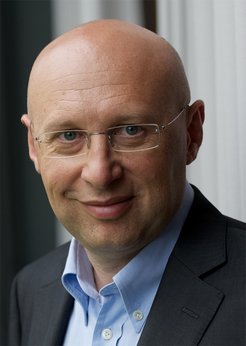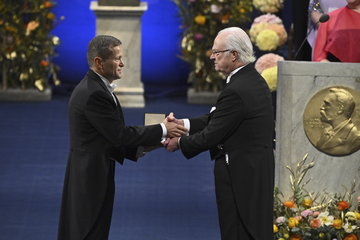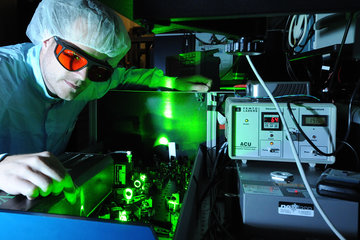Stefan Hell receives Kavli Prize in Nanoscience
One of the world's highest honours goes to Max Planck researcher in Göttingen
The one million US dollar Kavli Prize in Nanoscience was awarded to three scientists this year: Stefan W. Hell (Max Planck Institute for Biophysical Chemistry, Göttingen), Thomas W. Ebbesen (University of Strasbourg) and Sir John B. Pendry (Imperial College, London) have received the honor for their contributions to nano-optics, which have broken long-held beliefs about the resolution limits in optical microscopy and imaging. King Harald of Norway awarded the prize at a ceremony in the Oslo Concert Hall on September 9.

The Göttingen-based researcher Stefan Hell is being honored with the Kavli Prize "for ground-breaking developments that have led to fluorescence microscopy with nanometer scale resolution, opening up nanoscale imaging to biological applications," to quote the jury's reasoning. The distinction is awarded jointly every two years by the Norwegian Academy of Sciences and Letters, the Kavli Foundation, and the Norwegian Ministry of Education and Research.
Stefan Hell was sitting in his office when he received the unexpected call from Oslo. “I was just completing and about to send out a scientific publication when the President of the Norwegian Academy of Sciences and Letters called me on my mobile phone. I was totally surprised and am of course highly delighted about this honor. This means a great recognition not just for me, but also for all my co-workers who have done research with me on high-resolution light microscopy.” There was also much enthusiasm about the news at the Max Planck Institute for Biophysical Chemistry in Göttingen. "We are all very much excited that Stefan Hell has received this highly recognized prize. It is a great honor for him and for our institute," the Managing Director Gregor Eichele said.
With new physical concepts, Hell has succeeded in fundamentally overcoming the physical limits of diffraction. He has revolutionized light microscopy and opened up completely new insights into the nano-universe of living cells. Conventional light microscopes cannot visually distinguish objects which are less than 200 nanometers (one millionths of a millimeter) apart. For biologists or physicians this means a tremendous restriction: For investigating structures in living cells, this resolution is not sufficient. The STED microscope and related methods invented and developed by Stefan Hell now allow to investigate cells with up to ten times better resolution.
The physicist's approach is based on a trick: Closely packed details are kept dark in turn by use of a special light beam, so that they light up not simultaneously, but sequentially. This allows to distinguish them under the light microscope. “One great advantage is that our method is based on a relatively general fundamental principle. The high resolution is thus far from its limits,” Hell emphasized. With his Departments of NanoBiophotonics at the Max Planck Institute for Biophysical Chemistry and for Optical Nanoscopy at the German Cancer Research Center (Heidelberg) he is intensively working on how to push the resolution limit even further.
For the prize winner, biology and medicine are the primary application areas for his method. “STED microscopy offers a huge potential for researching diseases or developing new medicines. We are still at the very beginning of exploiting this.”
About the prize winner
Stefan W. Hell (born 1962) received his doctorate in physics in 1990 from Heidelberg University and worked from 1991 to 1993 at the European Molecular Biological Laboratory (EMBL) in Heidelberg. After a three and a half year stay at the Universities of Turku (Finland) and Oxford (Great Britain) he moved to the Max Planck Institute for Biophysical Chemistry in Göttingen as Leader of a Max Planck Junior Research Group in 1997. Since 2002, he has been Director at the institute and Head of the Department of NanoBiophotonics. In addition, he has been heading the Department of Optical Nanoscopy at the German Cancer Research Center in Heidelberg since 2003. Stefan Hell has received numerous prizes and awards for his research achievements, including the 10th Deutscher Zukunftspreis of the Federal President (2006), the Gottfried Wilhelm Leibniz Prize and the State Prize of Lower Saxony (both 2008), the Otto Hahn Prize for Physics (2009), the Körber Prize for European Science (2011), the Science Prize of the Fritz Behrens Foundation (2012), and the Carus Medal of the German National Academy of Sciences Leopoldina (2013).
About the Kavli Prize
The Kavli Prize has been awarded every two years since 2008 jointly by the Norwegian Academy of Sciences and Letters, the Kavli Foundation, and the Norwegian Ministry of Education and Research. The Kavli Prize honors scientists for their ground-breaking discoveries in the three research fields astrophysics, nanoscience, and neuroscience. The award is endowed with 1 million US dollars (approx. 730,000 euros). If there is more than one prize winner in a category, the prize money is divided. The prize is named after the Norwegian-born Fred Kavli (1927-2013) who advanced pioneering research as a physicist, entrepreneur, and inventor.












